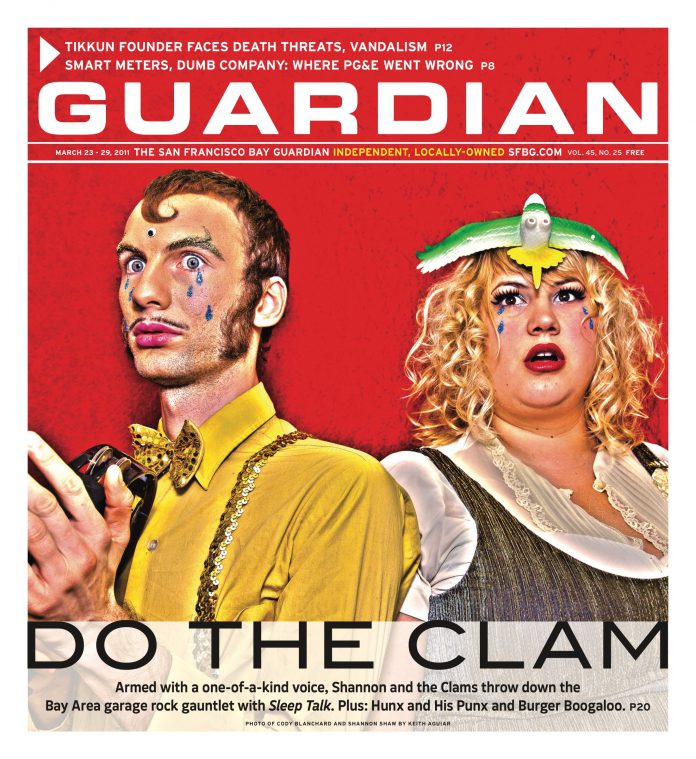arts@sfbg.com
VISUAL ART A sense of play — more street-smart than sentimental; international, but also attuned to a universal understanding of nature — is central to Yukako Ezoe’s art. Ezoe’s vividly colorful paintings and collages and vibrant jewelry work are informed by her experiences as a student and teacher, and often directly connected with everyday necessities and pleasures. Ezoe has curated and contributed to a show of kite art and made a revealing single-edition photo-interview book about the myriad barbershops in the Mission. She and her husband, the artist and DJ Naoko Onodera, often show work under the name Bahama Kangaroo, and she’s used that moniker for her first solo show, at Kokoro Studio. Ezoe has upcoming shows at Ritual Cafe and Edo Salon, and this week she’s taking part in “Rise Japan,” a fundraiser for earthquake and tsunami relief in Japan. We sat down together recently for a midafternoon talk.
SFBG How did the name Bahama Kangaroo come about?
Yukako Ezoe Naoki [Onodera] has an album titled Bahama Kangaroo. It’s beachy ’70s disco. Jonh Blanco and I were working on an event for Indie Mart and trying to figure out what the name of our craft team, and I asked Jonh to listen to the record. He said, “Our team should be Bahama Kangaroo!” Then Naoki and I ran with it.
SFBG The badminton dreamcatchers you’ve made have a number of facets: the spider’s web-like stringing and also the MP3s you place in the badminton racquets’ handles to record dreams or ideas. What was the inspiration behind them?
YE Futurefarmers had asked me to contribute to a show in which the theme was “What’s your learning journey?” While I went to school, I learned and got ideas while I was hanging out with friends and playing. So the voice recorder in the badminton dreamcatchers is like a memo or school tool.
The gold badminton dreamcatchers were part of a badminton show that Hana Lee, Leslie Kulesh, and I did at the Diego Rivera Gallery at San Francisco Art Institute. We turned the whole gallery into a gym.
SFBG Is there a creative interplay between your teaching and art making?
YE I think so. I get ideas from students. Seven-year-olds will draw something monstrous and I’ll be influenced by it.
The homeless kids I work with [at Larkin Street Youth Center] are super-ambitious and straightforward. They’ll crush something to make it fit within a work. The kids at Lark Inn are in survival mode. If I’m trying make a dreamcatcher, they don’t want to do it. If I do sewing or make wallets or notebooks, they’re into it.
SFBG Two artists mentioned in the writing connected to your current show at Kokoro Studio are John Audubon and Yokoo Tadonori. They make for a great, unexpected combination.
YE I love Yokoo Tadonori’s use of composition and his juxtapositions. One of his pieces has a salaryman hanging right in the middle of it. I don’t like it, but it’s brutal and cruel — and true.
SFBG Your compositions are often symmetrical. Why’s that?
YE I used to do monoprinting, and I was obsessed with the geometric [aspects of] library catalogs, airplane tickets, and blueprints. That’s stuck with me. I’m also OCD-ish, too, I have a whole bunch of drawers filled with weird things.
SFBG Kokoro Studio’s writing for “Bahama Kangaroo” also mentions self-portraiture, which might not be obvious when you look at the work. I went in wondering if there were going to be paintings of you.
YE No way! [laughs] A solo show is sort of about you — artist ego [laughs]. But the pieces are portraits of my thoughts and ideas. In one, I’m like an owl, spacing out and thinking. The two lions in some pieces are like me and Naoki doing a high five. Another piece, Too Many Bats, has to do with how hard and competitive it is to be an artist. I’ll think of people and turn them into characters.
SFBG Framing is present as an element within some of your recent paintings and collages. How did that come about?
YE I’ve been influenced by Afghan trucks. There’s a book of photos of them [Afghan Trucks, by Jean-Charles Blanc]. They’re a bit like trucks with murals on the side. Back in the day, travelers would decorate their camels with lucky charms so they’d have safe journeys, and nowadays they do it with trucks.
SFBG What are you working on at the moment?
YE Right now I’m making jewelry, altering clothing, and cleaning my room. I go back and forth [between different activities and forms].
I used to work for a bridal jewelry store that was really bling-y. I want my jewelry to be more sculptural, and to have a clustered quality that’s similar to the collages I make. *
BAHAMA KANGAROO: ART BY YUKAKO EZOE
Through Thurs/24
Kokoro Studio
682 Geary, SF
(415) 400-4110
RISE JAPAN: JAPAN EARTHQUAKE AND TSUNAMI RELIEF FUNDRAISER
Kokoro Studio
also: Gallery Heist
679 Geary, SF
(415) 563-1708

